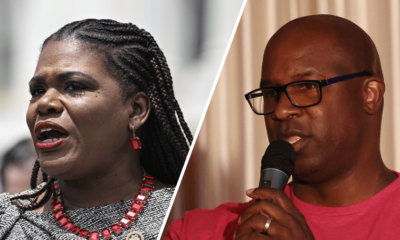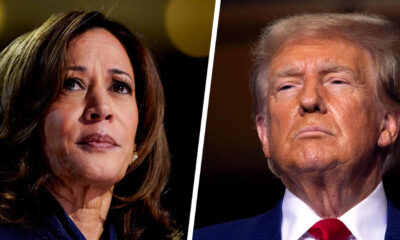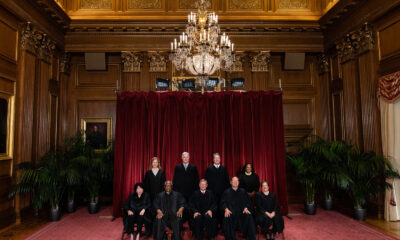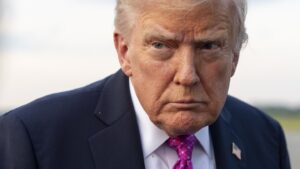Congress
Capitol agenda: GOP prepares a weekend jam for Democrats
Republicans are bracing for weekend work to push through a stopgap funding bill. The first step: reaching consensus on new money for member security.
The debate around the cost and viability of additional security measures — elevated in the wake of Charlie Kirk’s assassination — will come to a head in Tuesday morning’s House GOP conference meeting. Administration Committee Chair Bryan Steil (R-Wis.) will brief members on current security resources and what additional options might look like.
GOP leaders think the most viable plan is to extend the expiring pilot program — which provides security for members when they’re home in their districts — through the length of the continuing resolution. They’ve discussed a range of alternatives but are circling an additional $30 to $50 million, according to two people granted anonymity to describe the talks.
“I get it’s going to cost a lot of money, but funerals aren’t cheap either and we need to have some protection for certain members,” Rep. Tim Burchett (R-Tenn.) told reporters Monday.
If House GOP leaders unveil CR text later Tuesday as they hope, the chamber likely won’t vote until Friday. That means the Senate could be working on Saturday or beyond to meet Majority Leader John Thune’s target of wrapping things before next week’s scheduled recess.
And that’s if Democrats cooperate, which is a big “if.”
Meanwhile, the bigger picture is coming into focus as a group of GOP senators begin crafting legislation to extend expiring Affordable Care Act subsidies with policy changes designed to win over fellow Republicans.
Sen. Tommy Tuberville (R-Ala.) said Monday he was “part of the group that’s working on the wording to make sure we do it right.” It comes as more Republicans acknowledge the political risk of allowing insurance premiums to hike on Jan. 1.
But Democrats are still waiting for Republicans to sit down and negotiate a funding deal, which could encompass an extension of the ACA subsidies.
Senate Minority Leader Chuck Schumer and House Minority Leader Hakeem Jeffries have not publicly outlined a specific policy demand that Republicans would have to offer in order to secure votes for the CR. Instead, Schumer is pushing for a “bipartisan negotiation where we can address some of the grave harms Trump has caused to our health care system.”
Thune continues to wave off Democrats’ calls for more talks and is ruling out a deal on the expiring tax credits for now.
“I don’t know at this point if there’s a lot to talk about,” Thune told Blue Light News on Monday evening, adding that the subsidies “will be an issue for hopefully in November when the time comes.”
What else we’re watching:
— Patel hits Blue Light News: FBI Director Kash Patel will be in the congressional hot seat Tuesday in front of Senate Judiciary and Wednesday before House Judiciary. Expect lawmakers of both parties to grill him on the agency’s handling of the assassination of Charlie Kirk and its decision to withhold materials in the investigation into Jeffrey Epstein, along with firings at the bureau under Patel’s watch.
— Senators re-up tariff fight: Sen. Tim Kaine (D-Va.) is leading a bipartisan effort this week to force a vote that would roll back Trump’s “emergency” tariffs on Canada and Brazil. He and his allies, including Sen. Rand Paul (R-Ky.), think their past success with a similar measure and increased public anxiety about higher prices will earn them the necessary votes this time.
— Greene’s weather forecast: Rep. Marjorie Taylor Greene (R-Ga.) has previously stoked conspiracy theories about weather manipulation on social media. She’ll use her Oversight gavel Tuesday to elevate her concerns on Capitol Hill. Her DOGE subcommittee hearing will ostensibly examine cloud-seeding and solar geoengineering — methods that could increase rainfall or limit the amount of sunlight absorbed by the earth.
Meredith Lee Hill, Jordain Carney, Benjamin Guggenheim, Hailey Fuchs and Ari Hawkins contributed to this report.
Congress
House CR to be released Tuesday, GOP leaders say, setting up Friday vote
House GOP leaders said they plan to release a stopgap funding bill after a Republican conference meeting Tuesday, setting up a Friday vote on the short-term punt.
Majority Leader Steve Scalise said Tuesday morning that text of the continuing resolution through Nov. 20 would be released “hopefully” after the 9 a.m. GOP meeting. Speaker Mike Johnson said in a brief subsequent interview that he expects to release text later in the day.
A House vote Friday “is the plan,” Johnson said.
Responding to the assassination of conservative activist Charlie Kirk, GOP leaders are planning to add funding for an updated member security pilot program in the stopgap, according to three Republicans who spoke on condition of anonymity to describe the private deliberations. Those arrangements are expected to be discussed in the morning meeting of House Republicans.
Congress
The Senate’s doomsday scenario
Senators mostly agree the process for confirming a president’s nominees is broken. They also know it could easily get worse.
This week’s “nuclear” rules change by Senate Republicans — allowing most of President Donald Trump’s nominees to be confirmed in groups — is only the latest hammer lawmakers have taken to the once collegial nominations process.
The rancor could be turned up even higher, however, in a scenario the Senate hasn’t faced since it first changed the confirmation rules along party lines more than a decade ago: a newly elected president facing a majority of a different party.
Split government colliding with the first year of a president’s tenure has been rare in recent history. It hasn’t happened since 2001, when George W. Bush faced an ultra-tight Senate margin that flipped the majority back and forth between parties. And in the two decades since, the nominations process in the Senate has grown consistently more partisan, with more hurdles and longer wait times for confirmations.
The Senate saw a hint of how the chamber’s recent nominations warfare could play out in such a scenario in 2015 and 2016, when Republicans held the majority during the final two years of former President Barack Obama’s term. His second attorney general nominee, Loretta Lynch, waited five months to be confirmed. And that standoff was only a precursor for a cataclysmic battle that still hangs over the chamber today: then-Majority Leader Mitch McConnell’s decision to hold a Supreme Court seat open for more than a year.
But the stakes would be exponentially higher after a presidential election where every Cabinet position, not to mention hundreds of lower and mid-level executive branch nominees, plus any judicial vacancies, would need to be filled.
Sen. Kevin Cramer (R-N.D.) put McConnell’s move after Justice Antonin Scalia’s 2016 death in a category of its own, arguing that it was the pinnacle of the Senate’s recent confirmation fights. But he acknowledged a new president would need to “work with” an opposing majority if he or she wanted nominees confirmed.
Presidents, he said, would need to be “thoughtful” about nominees who are “confirmable.”
Yet bipartisan support for nominees has waned over the years, which has been reflected in the rising number of nominees who have had to overcome once rare procedural hurdles.
During the first 200 days of his second administration, Trump’s nominees faced the longest delay in recent administrations between nomination and confirmation, according to data from the Partnership for Public Service. And Democrats have forced nearly twice as many nominees to overcome procedural hurdles before a final vote compared to what Joe Biden faced from Senate Republicans by this same point.
Max Stier — president and CEO of the partnership, which runs an initiative focused on presidential transitions — said that Senate majorities have always had the ability to block nominations. But with the current rules change, he added, “the system that envisioned separation of powers is now seeing separation by party.”
“This is a significant ramping-up of that phenomenon,” he said. “The question is, are we watching our government being fully eaten up by the competition between teams?”
Gridlock from the minority party is what then-Majority Leader Harry Reid cited when Democrats first deployed the “nuclear option” in 2013 to lower the confirmation threshold for executive branch nominees and most judicial picks from 60 to 51. Republicans under McConnell took the same step in 2017 for Supreme Court picks and then sped up the debate time for most other nominees two years later.
“I don’t think the Democrats have ever voted for a Trump judicial [nominee] and I don’t want our side to become like that,” said Sen. John Kennedy (R-La.), predicting that “some Republicans, maybe not a majority,” would vote for a Democratic president’s nominees in the split scenario.
Some senators have recognized the pitfalls of the current partisan gridlock. Last week, a handful of lawmakers launched a last-minute effort to avert a party-line rules change, and those involved in the deal believed they were close to an agreement that would have allowed for the simultaneous confirmation of up to 15 nominees — an idea they believed could get supermajority support.
But they couldn’t get consent from all 100 senators to move forward, and Republicans — not convinced that Democrats would actually cut a deal — pulled the plug and moved forward with the party-line approach which allows for unlimited simultaneous confirmations. That brief glimmer of bipartisanship quickly gave way to recriminations about the calcifying fault lines in the chamber’s nominations fights.
“The nominations process is broken and in desperate need of an overhauling,” said Sen. Jeff Merkley (D-Ore.), who accused Republicans of watering down the Senate’s “advise and consent” role.
Sen. Tim Kaine (D-Va.) added that he worried “to some degree” about the possibility that a Republican Senate would stall Democratic nominees. But he also offered a warning: “I think they ought to be worried about a Dem president and a Dem Senate just putting people together in blocks.”
Democrats openly warned Republicans they were setting a precedent that could be used against them when they are out of power. Senate Minority Leader Chuck Schumer said it “won’t take very long for Republicans to wish they had not pushed the chamber further down this awful road.”
While Republican senators defended their decision to go nuclear — claiming some Democrats privately agreed the Senate was spending too much time processing nominations — they also acknowledged the threat of a larger war looms.
Sen. John Cornyn (R-Texas) said the possibility of interbranch gridlock amounted to “another problem” the Senate would eventually have to deal with.
“Nothing’s easy,” he added.
Congress
Senate confirms Trump adviser Miran to Fed board
The Senate voted 48-47 on Monday to confirm White House chief economist Stephen Miran to the Federal Reserve board, paving the way for him to participate in the central bank’s interest-rate setting meeting that begins Tuesday.
Miran’s addition to the Fed will be President Donald Trump’s first concrete mark on the institution during his second term, and it could give him unusually direct influence over a member of the central bank, which is designed to be insulated from short-term political pressures.
Miran is merely taking a leave of absence from his job as chair of the Council of Economic Advisers, rather than resigning, an arrangement that Republican senators decided not to contest, citing the fact that Miran’s term on the Fed is set to expire in January.
Trump has spent much of the year haranguing Fed Chair Jerome Powell for keeping rates elevated, and Miran has also suggested that borrowing costs should be cut. But Powell has already signaled that the Fed will lower rates this week regardless of the Trump adviser’s presence, citing weakening in the job market.
Miran, who holds a Ph.D. from Harvard University, says he plans to return to the White House at the end of his term, though he has not formally committed to leaving the Fed at that time and could stay on indefinitely unless the president taps someone else for the seat.
The length of his tenure could depend on whether Trump is successful in his bid to fire Fed board member Lisa Cook, a matter that is being litigated. If Cook stays at the central bank, Miran’s seat could be the only open spot available for Trump’s choice for Fed chair.
Before joining the White House, Miran proposed reforms to the Fed that would give the president more authority over the central bank, including making it easier to fire board members and shortening their 14-year terms.
Since his time in the administration, he has argued that tariffs are unlikely to lead to the kind of inflation that would require a policy response from the Fed. Powell, for his part, has cited uncertainty over the impact of tariffs on prices as a prime reason that he held the line on interest rates, but in recent weeks has cited risks to the job market as more pressing.
-
Uncategorized10 months ago
Bob Good to step down as Freedom Caucus chair this week
-

 The Josh Fourrier Show10 months ago
The Josh Fourrier Show10 months agoDOOMSDAY: Trump won, now what?
-

 Politics7 months ago
Politics7 months agoFormer ‘Squad’ members launching ‘Bowman and Bush’ YouTube show
-

 Politics10 months ago
Politics10 months agoWhat 7 political experts will be watching at Tuesday’s debate
-

 Politics10 months ago
Politics10 months agoHow Republicans could foil Harris’ Supreme Court plans if she’s elected
-

 The Dictatorship7 months ago
The Dictatorship7 months agoPete Hegseth’s tenure at the Pentagon goes from bad to worse
-

 The Dictatorship7 months ago
The Dictatorship7 months agoLuigi Mangione acknowledges public support in first official statement since arrest
-
Economy10 months ago
Fed moves to protect weakening job market with bold rate cut



